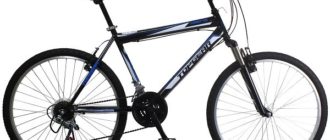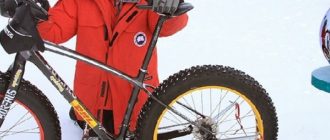The Soviet folding two-wheeled bicycle, which appeared on the market in the 90s, was considered a fop model. The compact and sturdy “Salyut” bicycle is called a well-deserved classic of the genre. The designers have found a simple and budget-friendly solution for all times. The road bike was produced without an upper tube, which allowed both girls and boys to ride. Thanks to the unique wheels, long handlebars and seatpost, the vehicle was used by both adults and teenagers. Models produced in 1986 are still in use today in their original form or after an upgrade.
History of Salyut bicycles
The biography of the symbol of the Soviet bicycle industry began at the Perm Machine Building Plant. The manufacturer of “working structures” for villagers and city dwellers produced two-wheelers “Ural” and “Progress”. It was extremely inconvenient to keep bulky road bikes in small apartments. The designers suggested a novelty – a reliable folding model, which became the most affordable mode of transport. In case of a breakdown, any malfunction could be repaired by the cyclist himself.
The lightweight “Salut”, designed for comfortable riding on roads with different surfaces, was liked by the citizens of the Union. It began to be produced in other cities (for example, Yoshkar-Ola). Later the family of bicycles was supplemented with an improved model “Salyut-C”. Toward the end of the Soviet Union, the Perm bicyclists released the fashionable Salyut-5 with a set of speeds and a reinforced frame. After the liquidation of the enterprise, bicycles under this brand have not been produced.
At the end of the XX century the company “Velomotors” was created, which produces two-wheeled vehicles under the Stealth brand. Quality folding bicycles are designed for beginner and intermediate level of riding.
Features of the bike
Road bike for active rides in the city has retained the general design to our time. Frames “Salut” produced three types:
- Folding with a hinge-type lock.
- Universal frame.
- Collapsible design, consisting of two half-frames, which are fixed by a handle or hexagon screw. Rare type of a frame not only in real life, but even on photos.
Manufacturers put the following features into collapsible or articulated bicycles:
- The rhombus-shaped folding frame is made of reliable steel alloy;
- steering column is adjustable in height and tilt;
- fork with a round section;
- the wheel with spokes (36 pcs.);
- two types of seats: hard with springs and soft with latex cushion;
- transmission elements made of aluminum;
- one speed mode;
- road pedals made of metal;
- luggage rack made of galvanized metal;
- alarm bell;
- brake leg.
Bicycle “Salute” with a wheel size of 24 inches was the best option for schoolchildren and adult bikers. The weight of the bike was 14.8 kg – compared to other models made in the Soviet Union, it was considered lightweight. The 533x37mm tires were designed for long use for riding on any road. The rear hub with foot brake increased the reliability characteristics of the whole design.
Features operation and maintenance
Road bicycles, which include “Salut” require compliance with the rules of operation and repair. The maintenance algorithm is shown in the table below.
| Regular maintenance | Action |
|---|---|
| Daily | Check wheel fasteners, tire wear, brakes |
| Once a week | Wash your bike with cleaning agents and a soft cloth Inspect the tension of the spokes Check the tightness of the fork bolts. |
| Monthly | Keep the frame free of cracks and corrosion. Check that threaded connections are secure Lubricate and grease parts with special grease |
| Every year | Lubricate bottom bracket, eccentric pins, pedals and seatpost Replace the bolts that hold it in place |
After the season is over, remove the wheels and wash the functional system with cleaning agents or kerosene. It is advisable to store your bicycle with inflated wheels in a hanging position.
General safety requirements should meet established standards. Wear a helmet, gloves with padded palm pads, and reflective equipment when riding a bicycle. Do not use tuklips in combination with an additional wing on the wheel, control the speed when riding, etc. Braking on the old model is not as effective as on modern bikes. So you have to consider the increase in braking distance.
Repair tips
Professionals advise assembling and repairing bicycles “Salut” in specialized workshops. Recommendations are due to the fact that various assemblies and components may differ from those installed on your bicycle. The practice of operating “Salut” shows that the repainted and well-groomed bike looks no worse than modern models.
How to do the repair yourself:
- Replace the old rubber with new, even if upon visual inspection it inspires confidence.
- “Achilles’ heel” “Salut” is considered an eight on the wheels. To eliminate the defect, tighten the spokes and strengthen the inner part of the rim with a protector to avoid a puncture.
- Attention in the service require pedals, which tend to loosen. This is due to the peculiar fastening in the form of connecting rods on wedges. Therefore, it is necessary to remove the part, clean it well and put it back in place.
- If the 4 mm balls have splintered, they can be replaced with modern bearings for “Salut”. They are identical in size to the old parts.
- If rust appears on the chain, the transmission unit is treated with sandpaper and soaked in kerosene. After drying, lubricate with oil or WD40.
- For safe braking, the seat is placed below the normal seating level. It is not recommended to change the frame geometry.
- If the frame is damaged, it can be repaired by welding.
- Durable handlebars do not require repair. It is enough to replace the grips or lubricate the bearings in the handlebar cup.
Is it possible to make an upgrade
The main features of the restoration of a bicycle from Soviet times:
- Some parts (such as the carriage or hub) will have to be completely replaced.
- For old tires it is difficult to find an analogue, so it is better to install new wheels. Many cyclists prefer a larger version of tires with a diameter of 26 inches.
- Restoration is subject to the saddle. After replacing the spring elements, cover the seat with modern material or buy a modern comfortable saddle.
- Fenders, necessary for riding in our climate, must be replaced. Not only is the bicycle accessory obsolete, the problem is also that the wire holding feathers are too close to the rubber. Stores offer a wide variety of quick-release, classic, plastic and other full-size fenders.
- Part of upgrading an old bike is installing a three-speed planetary hub.
- The carriage and connecting rod mounts are recommended to match the square section.
- Subject to replacement and the seatpost, which regulate the height of the saddle.
There are videos posted online showing step-by-step instructions for the upgrade.
Conclusion
The Salyut bicycle has stood the test of time. Many old models are now stored as rusting junk in barns. But the legend of the bicycle industry for 35 years remains a sought-after means of transportation. Durable and versatile, the bike adjusts easily to each rider, keeping the ride comfortable and safe.










In my opinion, a good option for the first bicycle for the younger generation, even if you look at the market of modern “sports” bicycles for children. Who thinks he needs this bike or not, the answer is yes!
I had a Salute in 1989-1990, my dad bought it for me as a ladies’ one because without a frame
Salutes appeared in the 70s, were all-frame and folding. The folding version is called “Salyut-C”, the usual one is simply “Salyut”.